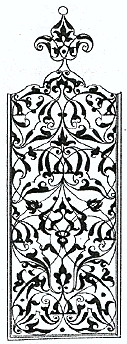Moresque


Moresque is an obsolete alternative term to "Moorish" in English, and in the arts has some specific meanings. By itself the word is used of forms found in ornament and decoration in the applied arts in Europe. Often it is a synonym for arabesque or interlace patterns in the Mannerist and Northern Mannerist styles of the 16th century, derived from Islamic ornament. It was defined in 1611 by Randle Cotgrave's A Dictionarie of the French and English Tongues as: "a rude or anticke painting, or carving, wherin the feet and tayles of beasts, &c, are intermingled with, or made to resemble, a kind of wild leaves, &c." [1] The word is also used for such a figure, starting off as a human or animal, but terminating as part of a decorative scheme of foliage or geometric strapwork.
In fact the origin of figures like those described by Cotgrave comes not from the Islamic world, but from the Renaissance version, influenced by the Ancient Roman grotesque decorative style, of medieval ornament, especially that found in illuminated manuscripts. Here men and beasts whose forms disappear into geometric or foliage decoration go back almost a thousand years to the interlace of Insular art seen in the Book of Kells and other manuscripts. These themselves derive from the Animal style of barbarian Europe. However the term "moresque" is not used of these medieval versions.
Other uses
- "Moresque dance" is a fancy term for the English Morris dance (OED, quoting Chambers' Cyclopaedia, or Universal Dictionary of Arts and Sciences, 1727). See also the Renaissance Moresca dances of France and Italy, called "moresques" in French.
- Hispano-Moresque ware is a type of medieval and Renaissance fine pottery produced in Spain by both Muslims and Christians.
- The term "Hispano-Moresque" is also used to describe figured silk textiles with geometric patterns woven in medieval Andalusia.[2]
- In 18th century French, moresques were "large loose comfortable pantaloons of thin printed calico".[3]
See also
References
- ^ OED, "Moresque"
- ^ Monnas, Lisa. Merchants, Princes and Painters: Silk Fabrics in Italian and Northern Paintings 1300–1550. London and New Haven, Yale University Press, 2008, p. 63
- ^ Google books
Further reading
- Abdullahi Y., Embi M. R. B (2015). Evolution Of Abstract Vegetal Ornaments On Islamic Architecture. International Journal of Architectural Research: Archnet-IJAR.
{{cite book}}: External link in|title=

